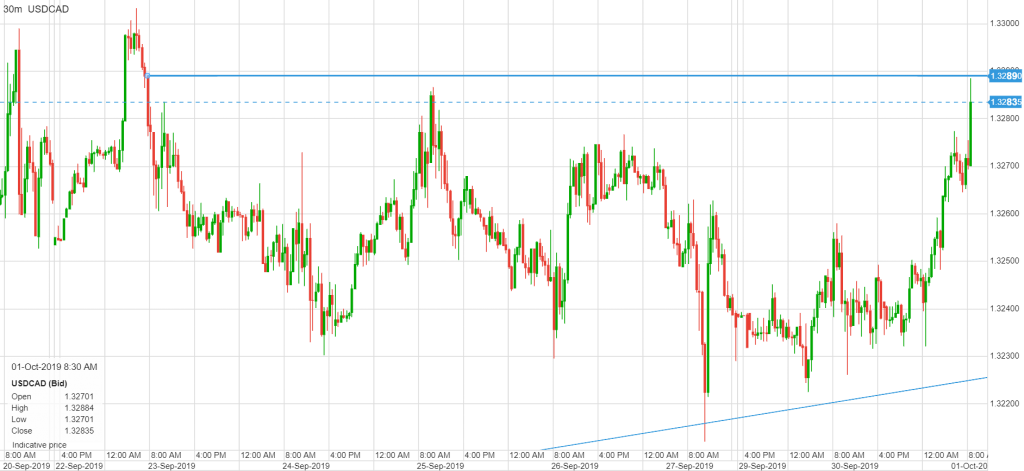
October 1, 2019
USDCAD open 1.3273-77 (6:00 am EDT) Overnight Range 1.3236-1.3277
USDCAD popped above the overnight high of 1.3277 to touch 1.3288 after Canada July GDP came in flat. Economists expected growth at 0.1%, compared to 0.2% in June. In is not as bad as it looks. Statistics Canada said “on a three-month rolling average basis, real GDP increased 0.8%, unchanged from June.”
The US dollar opened with gains across the board, led by losses in AUDUSD. However, since then, GBPUSD has accelerated lower on new Brexit drama.
FX Market Snapshot
Change in currency value against the US dollar from New York close to New York open

GBPUSD fell from 1.2305 to 1.2262 on Boris Johnson’s supposedly “leaked” Irish border plan, which called for a series of check-points in a 5-10 mile area around the border. Irish and EU officials scoffed at them. Johnson has since denied the accuracy of the leaks but didn’t want to say more until his plan could be shared with EU officials. GBPUSD bounced to 1.2300 in New York trading but then turned lower, again, falling to 1.2235. GBPUSD traders resumed selling after Boris Johnson said that Irish customs checks will be a reality after Brexit.
EURUSD recovered its overnight losses as New York opened, rising from 1.0880 to 1.0903. Prices got a bit of support from slightly better September Markit Manufacturing PMI which ticked up to 45.7 from 45.6. It is still soft. Core CPI was unchanged at 1.0%, which was expected.
USDJPY rallied to 108.46 from 108.05 but has since pared those gains. Japan bumped its national sales tax rate to 10%. The Tankan Survey was 5, a poor result. Japanese Government Bond futures (JGB’s) after the Bank of Japan suggested it would reduce purchases of long-dated bonds. Prices were underpinned when US 10-year Treasury yields climbed to 1.732% from 1.673%
The Reserve Bank of Australia (RBA) celebrated Oktoberfest with a rate cut. AUD, NZD, and CAD toasted the news by losing value against the US dollar. China was closed for National Day celebrations, Japan’s sales tax increased to 10% from 8.0%, and UK Prime Minister Boris Johnson’s Irish border plan was not well received.
Today’s US data calendar includes ISM Manufacturing (forecast 50.1) and Construction Spending.
USDCAD Technical View
The intraday USDCAD technicals are modestly bullish inside a 1.3230-1.3290 range. Longer term, prices need to break above 1.3340 or below 1.3170, which would trigger a 0.0100-point move in either direction. Until the, USDCAD is rangebound, tracking broad US dollar sentiment. However, if the Bank of Canada decides to lower interest rates like the RBA, RBNZ, EU and Fed, USDCAD should revisit 1.3550. For today, USDCAD support is at 1.3230 and 1.3190. Resistance is at 1.3290 and 1.3310. Today’s Range 1.3240-1.3310.
Chart: USDCAD 30 minute

Source: Saxo Bank





